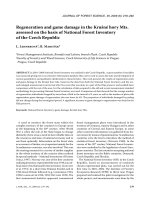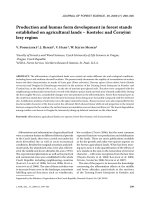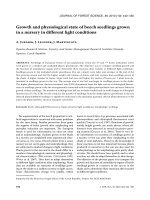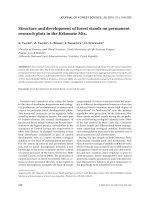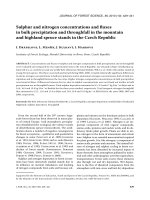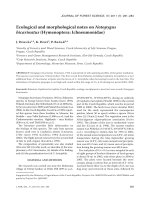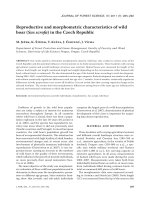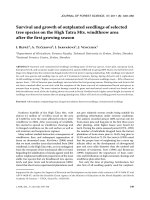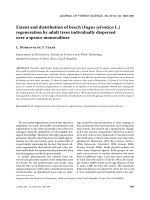Báo cáo lâm nghiệp: "Photosynthesis and leaf longevity in alder, birch and ash seedlings grown under different nitrogen" ppsx
Bạn đang xem bản rút gọn của tài liệu. Xem và tải ngay bản đầy đủ của tài liệu tại đây (163.04 KB, 3 trang )
Photosynthesis
and
leaf
longevity
in
alder,
birch
and
ash
seedlings
grown
under
different
nitrogen
levels
T.
Koike
1
M. Sanada
2
1
Swiss
Federal Institute
of Forestry
Research,
8irmensdorf ZH,
Swi!zerland,
and
2
Hokkaido
Branch,
Forestry
and
Forest
Products
Research
Institute,
Sapporo,
Japan
Introduction
With
application
of
nitrogen
fertilizers,
photosynthetic
rates
increase
(Field
and
Mooney,
1986)
and
the
leafy
period
is
pro-
longed
(Linder
and
Rook,
1984).
There
is
a
negative
correlation
between
the
maxi-
mum
photosynthetic
rate
and
its
duration
(Koike,
1987).
However,
there
is
little
infor-
mation
about
the
longevity
of
individual
leaves
after
nitrogen
treatments
(Linder
and
Rook,
1984).
We
report
the
relation-
ship
between
photosynthetic
rates
and
leaf
longevity
of
deciduous
broad-leaved
tree
seedlings
in
relation
to
the
anatomical
characteristics
in
leaves.
Materials
and
Methods
One
yr
old
seedlings
of
alder
(Alnus
hirsuta
Turcz.),
birch
(Betula
maximowicziana
Regel)
and
ash
(Fraxinus
mandshurica
Rupr.
var.
japonica
Maxim.)
were
planted
in
unglazed
pots
(diameter:
21
cm)
filled
with
surface
soil
of
the
nursery
including
volcanic
ash
(Sanada,
1975).
As
nitrogen
fertilizers,
ammonium
sulfate
was
supplied
4
times
in
each
pot.
Phosphate
ammo-
nium
(0.2
g)
was
provided
as
basal
dressing.
Until
the
final
supply,
total
amount
of
nitrogen
in
each
pot
was
5.0,
1.5,
1.0
and
0.35
g.
Sup-
plying
date
and
the
percentage
against
the
total
amount
was
July
1
40%;
July
24
20%;
Aug.
20
20%;
and
Sept.
15
20%,
respectively.
Gas
exchange
rates
were
determined
by
an
open
system
with
an
infrared
gas
analyzer
(URA2S,
Shimadzu)
in
the
summer
of
1984.
Air
was
stored
in
an
airbag
and
was
humified.
The
flow
rate
into
the
chamber
(20
x
18
x
1.8
cm
3)
was
66.7
cm
3
-s-
1.
Measurement
conditions
were
regulated
strictly
with
an
artificially
illumi-
nated
chamber
(Koike,
1987).
Leaf
temperature
was
kept
at
the
optimum
temperature
of
20°C
and
was
monitored
by
a
copper-constantan
thermocouple.
After
gas
exchange
measure-
ments,
leaf
area
was
determined
by
an
area
meter
(AAM5,
Hayashi).
Dry
weight
of
leaves
was
measured
after
drying
at
85°C
for
48
h.
Leaf
chlorophyll
was
extracted
with
80%
ace-
tone.
Leaf
nitrogen
content
was
determined
by
a
C-N
corder
(MT
500
W,
Yanagimoto).
Each
measurement
was
replicated
3-5
times.
Results
The
photosynthetic
rate
at
light
saturation
in
each
species
was
increased
with
increasing
nitrogen
content
(Fig.
1).
With
increasing
nitrogen
levels,
the
dark
respi-
ration
rate
at
20°C
in
alder
and
birch
was
increased
but
was
lower
in
ash.
The
ap-
parent
quantum
yield
of
all
species
was
increased
with
the
increasing
nitrogen
content.
In
all
species,
leaf
longevity
decreased
with
an
increase
in
the
nitrogen
content
in
leaves
(Fig.
2).
The
chlorophyll
content
in
leaves
of
all
species
increased
with
increasing
nitrogen,
especially
in
birch.
Small
differences
in
the
specific
leaf
weight
in
alder
and
in
birch
were
observed
between
nitrogen
treatments.
The
leaf
thickness
in
leaves
of
birch
and
ash
increased
with
an
increase
in
nitrogen
content,
as
compared
with
alder
leaves.
The
mesophyll
surface
area
per
unit
area
(A
mes/A;
see
Nobel,
1977)
in
all
spe-
cies
increased
with
increasing
nitrogen
content.
Discussion
For
all
species,
photosynthetic
rates
increased,
while
the
mean
longevity
of
individual
leaves
decreased
with
in-
creasing
nitrogen
content
in
leaves.
Based
on
the
individual
levels
(Schulze
and
Chapin,
1987),
the
leaf
longevity
was
diminished,
while
the
number
of
newly
produced
leaves
increased
(Linder
and
Rook,
1984).
If
nitrogen
were
available,
trees
could
produce
new
leaves
with
high
photosynthetic
capacity
and
could
quickly
shed
their
decaying
leaves.
These
pheno-
mena
were
reviewed
for
many
species
(Field
and
Mooney,
1986;
Schulze
and
Chapin,
1987).
With
increasing
leaf
nitro-
gen,
the
A
mes
/A
and
leaf
thickness
in-
creased.
These
structural
changes
in
leaves
seem
to
increase
photosynthetic
organs
and to
diminish
C0
2
diffusion
resistances.
The
leaves
containing
high
nitrogen
show
high
photosynthetic
rates,
while
these
leaves
were
short-lived
because
they
are
easily
attacked
by
herbivores
(Mooney
and
Gulmon,
1982).
These
authors
emphasized
that
there
was
a
posi-
tive
correlation
between
leaf
longevity
and
the
amount
of
defense
chemicals
against
herbivores
in
leaves.
In
the
present
study,
we
found
a
strong
correlation
between
the
cuticle
ratio
(i.e.,
the
ratio
of
cuticle
layers
in
a
leaf
to
leaf
thickness)
and
leaf
lon-
gevity
(Fig.
3).
Cuticle
layers
may
not
only
restrict
extra-transpiration
but
also
form
a
support
part
of
leaves.
No
relationship
between
the
cuticle
ratio
and
leaf
longevity
in
alder
leaves
was
found.
The
weak
response
of
alder
leaves
to
nitrogen
fertilizer
may
be
attributed
to
the
activity
of
nitrogen-fixing
microor-
ganisms
in
its
root
system.
Birch,
an
early
successional
species,
could
grow
quickly
with
use
of
nitrogen.
Ash,
a
gap
phase
species,
hardly
seems
to
respond
to
nitro-
gen
in
soil
with
volcanic
ash
(Ootomo
and
Nishimoto,
1984).
Acknowledgments
We
thank
R.
Hasler,
H.
Keller,
H.
Turner,
Y.
Sakagami
and
P:.
Takahashi
for
their
helpful
comments.
Financial
support
from
the
Swiss
Federal
Institute
of
Forestry
Research
is
grate-
fully
acknowledged.
References
Field
C.
&
Mooney
H.A.
(1986)
The
photosyn-
thesis-nitrogen
relationship
in
wild
plants.
In:
On
the
Economy
of
Plant
Form
and
Function.
(Givnish
TV.,
ed.),
Cambridge
University
Press,
Cambridge,
pp.
2;5-55
Koike
T.
(1987)
Photosynthesis
and
leaf
expan-
sion
in
leaves
of
early,
mid,
and
late
succes-
sional
tree
species,
birch,
ash,
and
maple.
Photosynthetica
21, 503-508
Linder
S.
&
Rook
D.A.
(1984)
Effects
of
mineral
nutrition
on
carbon
dioxide
exchange
and
parti-
tioning
of
carbon
in
trees.
In:
Nutrition
of
Plan-
tation
Forests.
(Bowen
G.D.
&
Nambiar
E.K.S.,
eds.),
Academic
Press,
London,
pp.
221-236
Mooney
H.A.
&
Glumon
S.L.
(1982)
Constraints
on
leaf
structure
and
function
in
reference
to
herbivory.
BioSci
6
-nce
32, 198-206
Nobel
P.S.
(1977)
Internal
leaf
area
and
cellular
C0
2
resistance:
photosynthetic
implications
of
variations
with
growth
conditions
and
plant
spe-
cies.
Physiol.
Plant.
40, 137-144
Ootomo
R.
&
Nishimoto
T.
(1984)
Growth
re-
sponse
to
fertilizer
in
deciduous
broad-leaved
trees
in
Hokkaido
(III)
Response
to
soil
charac-
teristics.
Hokkaid>J
Branch.
Jpn.
For.
Soc.
33,
52-54
Sanada
M.
(1975)
Examinations
of
macro-
elements
and
optimum
nitrogen
supply.
Annu.
Rep.
Hokkaido
E3ranch
Gov.
For.
Exp.
Stn.
Norinsho
Ringya
Shikenjo
Hokkaido
Shijo
Nenpo
S50,
69-7E;
Schulze
E.D.
&
Chapin
F.S.
III
(1987)
Plant
spe-
cialization
to
environments
of
different
resource
availability.
In:
F’otentials
and
Limitations
of
Ecosystem
Analysis.
(Schulze
E.D.
&
Z61fer
H.,
eds.),
Springer-Verlag,
Berlin,
pp.
120-148
